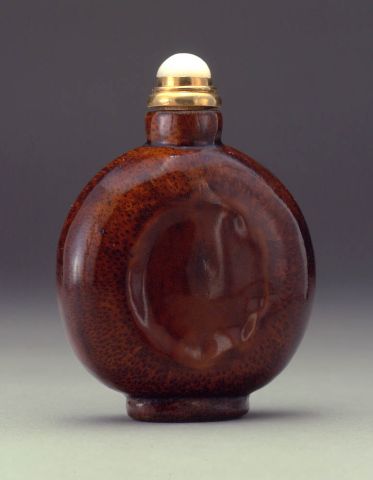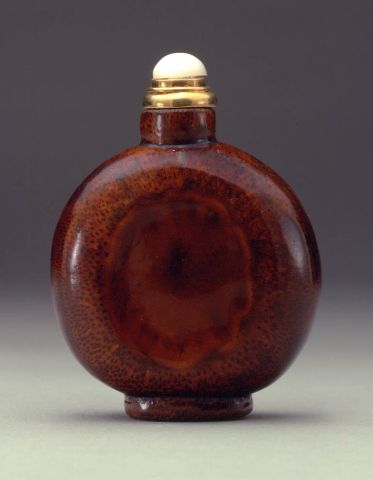

Bottle ID: 648
LACQUERED
Date: 1780-1880
Height: 60 mm
Bamboo, of flattened circular form, with slightly concave area to the two main sides, the brown surface polished and covered overall with a shiny lacquer.
Similar Examples:
Lawrence, Clare. The Alexander Brody Collection of Chinese Snuff Bottles, 1995, p. 40, no. 55.
Moss, Hugh, Victor Graham and Ka Bo Tsang. A Treasury of Chinese Snuff Bottles - The Mary and George Bloch Collection, Vol. 7, Part 1, pp. 40-41, no. 1479.
Hall, Robert. Chinese Snuff Bottles, 1987, pp. 22-23, no. 9.
Provenance:
Robert Hall
Bamboo was much revered by the Chinese, admired for its strength, uprightness and ability to bend without breaking, all qualities that (apparently) were also admired in the human character, and particularly in a gentleman. Although a commonplace material in China, items made from bamboo were respected and acquired great value and status, particularly among the literati. This plain, simple bottle, beautifully shaped and perfectly symmetrical, exudes natural charm. It was made by removing a section from the node that separates the lower segments in a bamboo stem. The cross-section of the stem reveals the delicate, naturally attractive markings of the layers within. A further pleasing feature is the concave surface on each side, allowing these to be used as integral snuff dishes if so wished. Lacquered bamboo bottles are rarely found and as such this example has been dated on the basis of, amongst other features, its slightly larger size and shape which compares to glass bottles from the Daoguang period onwards. However, the Archives of the Imperial Household Department which were managed by Prince Yi of the Blood, Yinxiang, (1686-1730) in the first half of the Yongzheng period, mention in the first year of Yongzheng: " a varnished carved bamboo snuff bottle" to be delivered from the Palace workshops. This is the earliest record of a bamboo snuff bottle and is intriguing that it specifically mentions that it is varnished, thus excluding the 18th century veneer group that today's scholars more readily associate with the Palace Workshops.
< Back to full list
 English
English 中文
中文